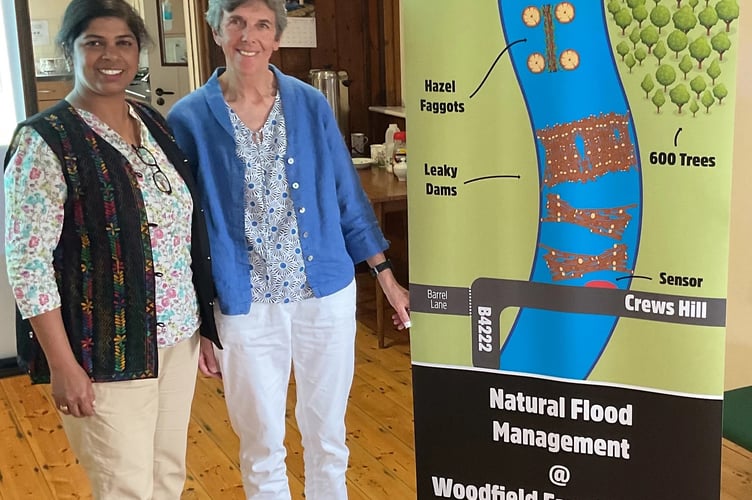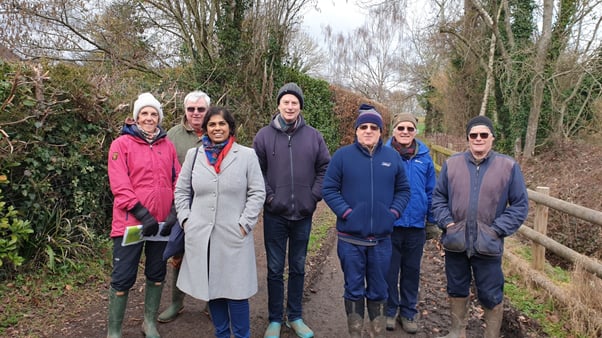THE village Aston Ingham is no stranger to flooding as it has suffered from its effects on a regular basis over many years.
Local residents believe the situation has got significantly worse over the years, but it was the flooding on December 23, 2020, which was the catalyst for community action.
The disgruntled residents formed the Aston Ingham Flood Action Group with 10 keen volunteers.
The action group believes that the surface water field run off, which drains into three main streams towards the village often results in flooding under specific conditions, threatening dwellings in its wake.
Maggie Pettit chairman of Aston Ingham Flood group explains that vulnerable parishioners in the village live in what she describes as the bottom of a bowl, surrounded by hills which can release huge volumes of water, overwhelming existing drainage channels.
Ms Pettit said: “What used to pass as bone fide flood management strategies, like the widening of culverts, deepening ditches and dredging, these were no longer seen as viable approaches.
“Instead, flooding is alleviated by ‘slowing the flow’, the main strategy within Natural Flood Management, offering nature-based solutions. In this way water runoff is reduced and controlled.”
Ms Pettit added that the harsh reality was that Aston Ingham did not meet any criteria for funding from the Environment Agency or other bodies because it is a small village, which was not close enough to a major river and neither were the vulnerable areas large enough to warrant major investment.
But after two years of fighting bureaucracy and little progress, the volunteers felt deflated and considered the only option open to them was to give up.
However, a research trip to the Flood Expo at Birmingham’s NEC proved to be beneficial as members spoke with Dr Namrata Bhattacharya-Mis, a senior lecturer at University of Chester, who was no stranger to flooding issues in smaller catchments and she had already identified funding through the ‘Build Back Better’ scheme.
Additionally, University of Chester’s existing flood risk research team were already working with Andel, a water sustainability company who are keen to develop equipment to measure rainfall and water levels supporting the monitoring and evaluation of Natural Flood Management.
Ms Pettit said that with the help of Dr Namrata, funding for the scheme was available and this sum was subsequently matched by Aston Ingham Parish Council.
A scoping visit to the area was made by Dr Namrata and Gerbren Haaksma from Andel to identify sites for sensors with members of the Flood Group.
The flood group agreed a way forward with the local community to place three sensors in the tributaries, a rain gauge and a gateway to receive data from the sensors and the resulting data would be shared.
Because the water from Aston Ingham drains into the River Leadon, Gloucestershire County Council began investigating initiating natural flood management projects which would also reduce the volume of water flowing into the river.
The first project at Woodfield farm, high in the Aston Ingham catchment, then began to take shape following Build Back Better grant funding, specialists from Andel were able to install sensors in the area.
Earlier this year leaky dams and hazel faggots installed in 400m of tributary in the Woodfield farm area. Some 600 trees will be planted later this autumn.

Ms Pettit said that Aston Ingham will be part of a wider case study through Chester University’s Research Impact submissions. She explained that the flood group’s work will increase the community’s knowledge and understanding of natural flood management; implementing various strategies at New House farm; scope a third area for possibilities; develop flood alerts based on data from sensors following rainfall and continuing to increase positive relationships with farmers and landowners with the added support of catchment sensitive advisers.
Ms Pettit concluded: “Aston Ingham Flood Group have learned the value of networking, persistence and sheer hard work over three-and-a-half years. Our work continues to monitor the effectiveness of natural flood management. We are truly grateful to everyone who has played a part in supporting their efforts to date.”



.jpeg?width=209&height=140&crop=209:145,smart&quality=75)

Comments
This article has no comments yet. Be the first to leave a comment.